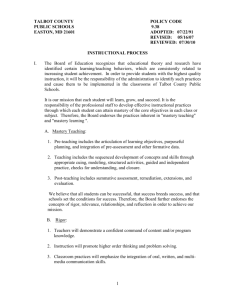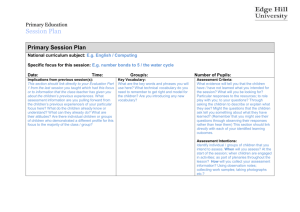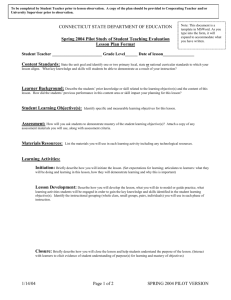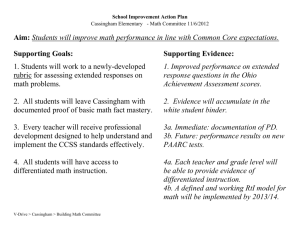Word
advertisement
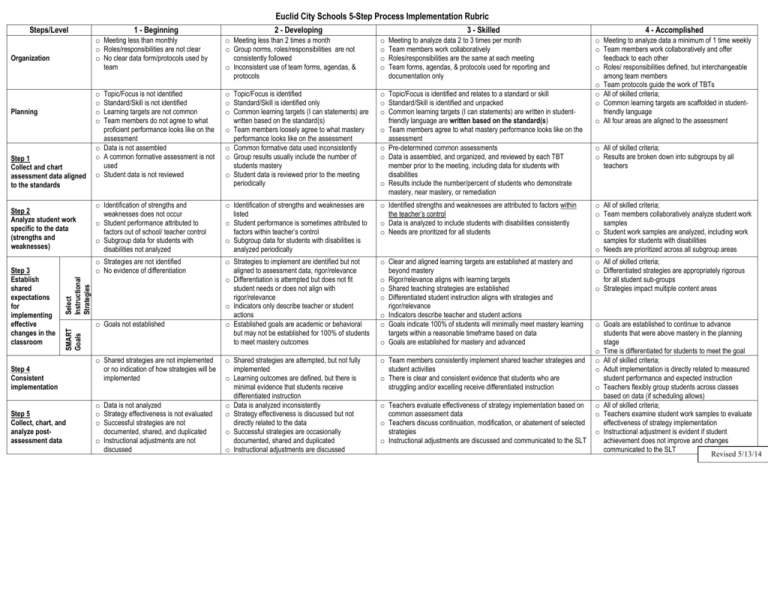
Euclid City Schools 5-Step Process Implementation Rubric Steps/Level Organization Step 1 Collect and chart assessment data aligned to the standards o Topic/Focus is identified o Standard/Skill is identified only o Common learning targets (I can statements) are written based on the standard(s) o Team members loosely agree to what mastery performance looks like on the assessment o Common formative data used inconsistently o Group results usually include the number of students mastery o Student data is reviewed prior to the meeting periodically o Topic/Focus is identified and relates to a standard or skill o Standard/Skill is identified and unpacked o Common learning targets (I can statements) are written in studentfriendly language are written based on the standard(s) o Team members agree to what mastery performance looks like on the assessment o Pre-determined common assessments o Data is assembled, and organized, and reviewed by each TBT member prior to the meeting, including data for students with disabilities o Results include the number/percent of students who demonstrate mastery, near mastery, or remediation o Identification of strengths and weaknesses does not occur o Student performance attributed to factors out of school/ teacher control o Subgroup data for students with disabilities not analyzed o Identification of strengths and weaknesses are listed o Student performance is sometimes attributed to factors within teacher’s control o Subgroup data for students with disabilities is analyzed periodically o Identified strengths and weaknesses are attributed to factors within the teacher’s control o Data is analyzed to include students with disabilities consistently o Needs are prioritized for all students o All of skilled criteria; o Team members collaboratively analyze student work samples o Student work samples are analyzed, including work samples for students with disabilities o Needs are prioritized across all subgroup areas o Strategies are not identified o No evidence of differentiation o Strategies to implement are identified but not aligned to assessment data, rigor/relevance o Differentiation is attempted but does not fit student needs or does not align with rigor/relevance o Indicators only describe teacher or student actions o Established goals are academic or behavioral but may not be established for 100% of students to meet mastery outcomes o Clear and aligned learning targets are established at mastery and beyond mastery o Rigor/relevance aligns with learning targets o Shared teaching strategies are established o Differentiated student instruction aligns with strategies and rigor/relevance o Indicators describe teacher and student actions o Goals indicate 100% of students will minimally meet mastery learning targets within a reasonable timeframe based on data o Goals are established for mastery and advanced o All of skilled criteria; o Differentiated strategies are appropriately rigorous for all student sub-groups o Strategies impact multiple content areas o Shared strategies are attempted, but not fully implemented o Learning outcomes are defined, but there is minimal evidence that students receive differentiated instruction o Data is analyzed inconsistently o Strategy effectiveness is discussed but not directly related to the data o Successful strategies are occasionally documented, shared and duplicated o Instructional adjustments are discussed o Team members consistently implement shared teacher strategies and student activities o There is clear and consistent evidence that students who are struggling and/or excelling receive differentiated instruction SMART Goals Step 5 Collect, chart, and analyze postassessment data o Shared strategies are not implemented or no indication of how strategies will be implemented o Data is not analyzed o Strategy effectiveness is not evaluated o Successful strategies are not documented, shared, and duplicated o Instructional adjustments are not discussed Meeting to analyze data 2 to 3 times per month Team members work collaboratively Roles/responsibilities are the same at each meeting Team forms, agendas, & protocols used for reporting and documentation only 4 - Accomplished Topic/Focus is not identified Standard/Skill is not identified Learning targets are not common Team members do not agree to what proficient performance looks like on the assessment o Data is not assembled o A common formative assessment is not used o Student data is not reviewed o Goals not established Step 4 Consistent implementation 3 - Skilled o o o o Select Instructional Strategies Step 2 Analyze student work specific to the data (strengths and weaknesses) 2 - Developing o Meeting less than 2 times a month o Group norms, roles/responsibilities are not consistently followed o Inconsistent use of team forms, agendas, & protocols o o o o Planning Step 3 Establish shared expectations for implementing effective changes in the classroom 1 - Beginning o Meeting less than monthly o Roles/responsibilities are not clear o No clear data form/protocols used by team o Teachers evaluate effectiveness of strategy implementation based on common assessment data o Teachers discuss continuation, modification, or abatement of selected strategies o Instructional adjustments are discussed and communicated to the SLT o Meeting to analyze data a minimum of 1 time weekly o Team members work collaboratively and offer feedback to each other o Roles/ responsibilities defined, but interchangeable among team members o Team protocols guide the work of TBTs o All of skilled criteria; o Common learning targets are scaffolded in studentfriendly language o All four areas are aligned to the assessment o All of skilled criteria; o Results are broken down into subgroups by all teachers o Goals are established to continue to advance students that were above mastery in the planning stage o Time is differentiated for students to meet the goal o All of skilled criteria; o Adult implementation is directly related to measured student performance and expected instruction o Teachers flexibly group students across classes based on data (if scheduling allows) o All of skilled criteria; o Teachers examine student work samples to evaluate effectiveness of strategy implementation o Instructional adjustment is evident if student achievement does not improve and changes communicated to the SLT Revised 5/13/14
